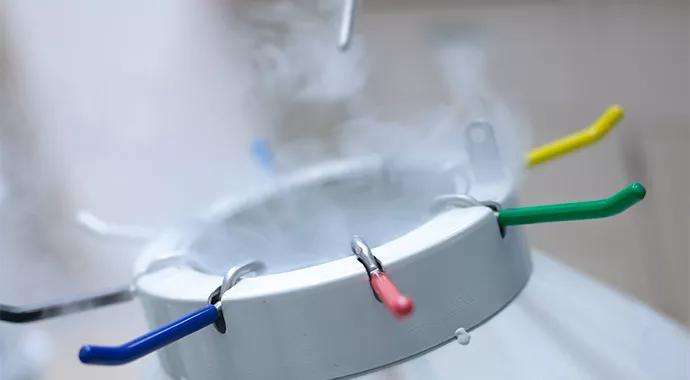Research examines vitrification, follicular viability, reimplantation

By Rebecca Flyckt, MD
Advertisement
Cleveland Clinic is a non-profit academic medical center. Advertising on our site helps support our mission. We do not endorse non-Cleveland Clinic products or services. Policy
Although many women with cancer are living longer healthier lives thanks to improved treatment options, the diagnosis of cancer still causes many worries for patients. A common concern for women and girls with a new cancer diagnosis is whether future childbearing will be difficult or even impossible after treatment. Treatments that cure malignancy can also damage the ovaries in a way that results in menstrual dysfunction, infertility or premature menopause. Perhaps the most at-risk population is prepubertal girls with cancer, who are not eligible to pursue gold standard fertility-preserving strategies like egg and embryo freezing.
For this population and for women who cannot or prefer not to undergo egg or embryo freezing, the Cleveland Clinic offers ovarian tissue freezing. The American Society of Reproductive Medicine still considers ovarian tissue freezing to be experimental in humans and this procedure can only be performed under an Institutional Review Board-approved protocol with detailed informed consent. To date, close to 100 live births have been reported worldwide using this technique. Cleveland Clinic offers ovarian tissue freezing for pediatric and adult populations, and tissue freezing has now been performed for dozens of women and girls at our institution.
Ovarian tissue freezing involves harvesting ovarian cortical tissue using outpatient laparoscopic techniques. This method allows rapid recovery and no delay in chemotherapy or radiation. Once the patient has recovered from cancer treatment and is ready to pursue fertility, the tissue can be retransplanted using fine sutures to secure the strips of ovary in position within the abdomen. Transplantation may not occur until decades after the original freezing procedure. Pregnancies can then be conceived either spontaneously or with the help of fertility treatments.
Advertisement
Because ovarian tissue freezing and transplantation are still experimental, ongoing research is underway to optimize the technique. At Cleveland Clinic, sheep models are being used to answer important questions in ovarian tissue freezing. For example, currently most in vitro fertilization (IVF) programs use vitrification (a rapid freezing technique) to freeze eggs and embryos, due to superior pregnancy and live birth rates. However, most live births using ovarian tissue have been obtained using a slow freezing technique, potentially because vitrification was not widely available at that time. Therefore, an important debate in fertility preservation research is whether slow freezing or vitrification yields better results for ovarian tissue.
In this Cleveland Clinic trial, portions of ovary from the same sheep are frozen at the Cleveland Clinic Fertility Center research lab using each of the two methods. The tissue is then thawed and reimplanted and studies of follicle viability are obtained for side-by-side comparison.
A secondary objective of the study is to determine whether follicles isolated from ovarian tissue can be reimplanted using a supportive matrix. This technique may help to reduce the risk of reintroducing cancer cells with implantation. This concern exists mainly for bloodborne cancers, such as leukemia, that may be found in ovarian tissue. Results from the trial are expected in 2018 and will hopefully shed light on these two very important questions in fertility preservation.
Advertisement
Advertisement

First full characterization of kidney microbiome unlocks potential to prevent kidney stones

Researchers identify potential path to retaining chemo sensitivity

Large-scale joint study links elevated TMAO blood levels and chronic kidney disease risk over time

Investigators are developing a deep learning model to predict health outcomes in ICUs.

Preclinical work promises large-scale data with minimal bias to inform development of clinical tests

Cleveland Clinic researchers pursue answers on basic science and clinical fronts

Study suggests sex-specific pathways show potential for sex-specific therapeutic approaches

Cleveland Clinic launches Quantum Innovation Catalyzer Program to help start-up companies access advanced research technology